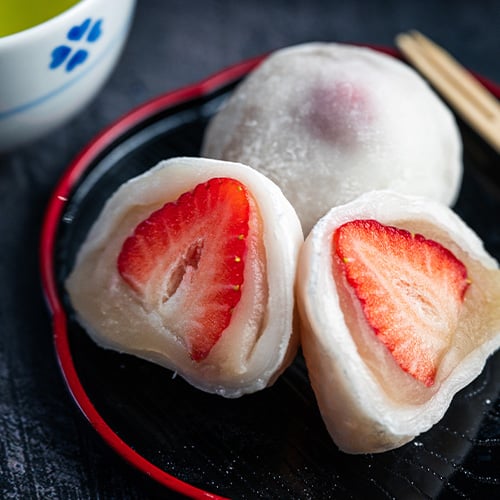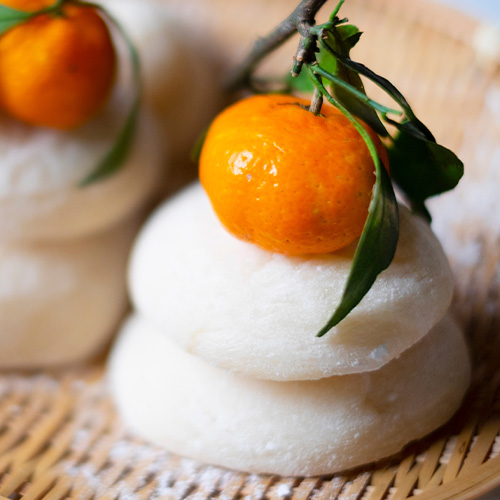Mochi, pronounced mow-chee, is a unique delicacy made from glutinous rice pounded with a wooden mallet until it forms a smooth, elastic paste with a chewy texture. The mochi dough is then shaped, flavored, and filled to create various confections and savory snacks. We guide you through the nuances of mochi dough, the different types of mochi, and mochi-inspired foods so you can add this time-tested yet trendy treat to your menu.
Shop All MochiWhat Does Mochi Taste Like?

When eaten independently, mochi's flavor is reminiscent of rice because it is made from glutinous rice pounded into a stretchy consistency. The resulting taste profile can be described as a cross between a marshmallow and buttered rice. Mochi’s neutral, starchy, subtly sweet base flavor pairs well with sweet and savory fillings or Asian sauces.
How to Eat Mochi
Due to its soft, slightly gummy texture, it is crucial to chew mochi thoroughly and not swallow it whole, as many first-time eaters tend to do. Mochi is considered a choking hazard if not eaten properly. Individuals who often have difficulty chewing properly, such as children or the elderly, are more likely to find eating mochi challenging. Avoid serving mochi in settings like elderly care centers or elementary school cafeterias to prevent any potential choking incidents.
Where Is Mochi From?
The origins of mochi can be traced back over a thousand years in Japan, where it was initially consumed as a special treat during religious ceremonies and celebrations. To this day, mochi plays a significant role in Japanese culture and is associated with various festivals and traditions. One of the most well-known events featuring mochi is the Japanese New Year celebration, where families gather to make and consume mochi as a symbol of good luck and prosperity for the coming year. Mochi is also commonly offered as a gift during special occasions and is believed to bring happiness and good fortune to both the giver and receiver.
Types of Mochi
Mochi comes in many flavors, shapes, and sizes. Our list of the most popular types of mochi with pictures provides a descriptive and visual guide to mochi varieties.
1. Sakura Mochi

Sakura mochi is a traditional Japanese confection that features sweet red bean paste encased in pink-hued mochi, a gummy rice cake, and wrapped in a pickled cherry blossom leaf. Whether the cherry blossom leaf is eaten comes down to individual preference.
Sakura mochi is particularly popular during spring in Japan as a symbol of the cherry blossom season. The pink color of the mochi and the cherry blossom leaf wrapping evoke the beauty and delicacy of the cherry blossoms. It’s also a popular treat at the Japanese festival, Hinamatsuri (also known as Girls’ Day), celebrated annually on March 3rd.
2. Warabi Mochi

Warabi mochi is a unique variation of traditional mochi and offers a jelly-like texture. This type of mochi is made from bracken starch, a flavorless starch derived from the rhizomes (underground stems) of the bracken fern. Warabi mochi is often enjoyed dusted with nutty roasted soybean flour, adding an umami element to its sweet flavor profile.
To enhance the taste experience, warabi mochi is typically drizzled with kuromitsu syrup, which translates to "black honey" in Japanese. Kuromitsu is made from unrefined kurozato, or black sugar, known for its rich, molasses-like flavor and dark color. The kuromitsu syrup adds depth and complexity to the overall taste of warabi mochi, making it a popular choice for those looking to indulge in a unique and delicious treat.
3. Daifuku Mochi

Daifuku mochi is a stuffed variation of traditional mochi. One of the most common fillings used in daifuku mochi is red bean paste, giving it a sweet and flavorful center. When daifuku mochi is filled with red bean paste, it is often called anko daifuku. This variation is a favorite among those with a sweet tooth and is typically enjoyed as a dessert.
Another popular type of daifuku mochi is matcha daifuku, which features a unique green tea flavor profile. Matcha daifuku can come in two forms: a white, plain mochi dough exterior stuffed with green tea filling, or a green mochi exterior created by mixing culinary-grade matcha into the mochi dough stuffed with a white bean filling. Either variation offers a balance of textures and flavors, combining the chewiness of the mochi with the aromatic essence of matcha.
4. Kagami Mochi

Kagami mochi is a special type of mochi that holds significant cultural importance in Japan, particularly during the celebration of the Japanese New Year. This seasonal mochi translates literally into “mirror rice cake” and is characterized by its perfectly white appearance with two stacked mochi layers. The mochi is steamed and pressed into shape, with the top layer slightly smaller than the base mochi.
Kagami mochi is typically adorned with a small dai dai mandarin on the top, complete with an attached leaf. Some variations of kagami mochi may also feature a sheet of kombu (seaweed) and a skewer of dried persimmons, while other regions may incorporate different decorative elements. For instance, some areas throughout Japan use three-layer kagami mochi, each layer symbolizing aspects of the New Year tradition.
5. Kinako Mochi

Kinako mochi, also known as rice cake with soybean flour, is a delightful Japanese treat that combines the chewy texture of rice cakes with the sweet and nutty flavor of soybean flour. Kinako, also known as roasted soybean flour, has a mild, slightly nutty flavor. However, when paired with a little salt and sugar, its earthy flavors come to the forefront, and kinako transforms into a delicious sweet and savory topping.
The beauty of kinako mochi lies in the contrast of textures and flavors. The sticky rice cakes are dusted in a generous amount of kinako powder, creating a harmonious blend of chewy and crunchy, sweet and nutty. The moisture from the mochi helps to balance out the dryness of the kinako powder, resulting in a satisfying and enjoyable eating experience.
6. Yaki Mochi

Yaki mochi, which translates to "grilled mochi" in English, is mochi cooked with direct heat through grilling, broiling, or pan frying until it puffs up and lightly browns on the outside. This cooking process gives yaki mochi a unique texture with a crispy skin and gummy interior. Due to a clever linguistic connection, yaki mochi carries culinary importance and symbolic significance in Japanese culture. The term yaki, meaning "to grill," also conveys the concept of envy. This symbolic meaning may have originated from a traditional love-prediction game in which individuals would burn mochi to determine the success of their relationships.
When it comes to taste, yaki mochi is often likened to a toasted marshmallow without the excessive sweetness. This makes it a versatile dish that can be savory or sweet, depending on how it is seasoned. In Japan, soy sauce and sugar, as well as kinako (roasted soybean flour) and sugar, are the two most common toppings used to enhance the flavor of yaki mochi. The combination of soy sauce and sugar creates a savory-sweet profile that complements the subtle taste of the mochi, while kinako and sugar offer a nutty, slightly sweet contrast that adds depth to the dish.
7. Hishi Mochi

In Japan, hishi mochi is a symbolic ceremonial dessert often presented as an offering to Hina Matsuri dolls during the days leading up to Girl’s Day, a festival that celebrates the growth of girls and wishes them happiness. The diamond shape of hishi mochi is believed to represent fertility, and the tricolor combination of red, white, and green is also rich in symbolism. Red symbolizes health and happiness, white represents purity and cleanliness, while green signifies growth and vitality.
The natural food coloring used to create each layer contributes to the unique flavor profile of hishi mochi. The pink layer is infused with jasmine, the white layer with water chestnuts, and the green layer with mugwort. While distinct when eaten separately, the layers effortlessly fuse to create an aromatic, floral, earthy, and subtly sweet confection.
8. Hanabira Mochi

Inspired by the beauty of plum blossom petals, the name hanabira translates to "flower petal" in English. To create hanabira mochi, the mochi is folded over fillings to form a semicircular shape, mimicking the appearance of a flower petal. Within the center lies a layer of anko, a sweet bean paste. The anko used is typically the white kind made from sweetened mung beans, subtly flavored with white miso. A delicate, pink layer of hishi mochi is folded into the center. From the outside, its pink color shows through in the middle and gradually fades to white at the edges. A thin strip of sweetly flavored gobo, burdock root, protrudes from the mochi on both sides.
In Japanese culture, every component of the hanabira mochi holds deep significance. The vibrant red hue subtly revealed beneath the pristine white mochi is reminiscent of the Japanese apricot/plum (ume) blossom. This blossom embodies values of purity, resilience, and new beginnings. The gobo symbolizes pressed ayu, a sweet fish native to East Asia, signifying wishes for longevity and prosperity. This artisanal confection is a staple during the festivities of the New Year, typically paired with the classic matcha tea.
9. Bota Mochi

To make bota mochi, mochi dough is formed into a ball and then coated with a firm, sweet red bean paste layer, enhancing its sweetness and adding complexity to each bite. In addition to the red bean paste coating, bota mochi can also be coated in kinako for a nutty flavor or sesame seeds for a satisfying crunch. Some variations of bota mochi are stuffed with fresh strawberries, adding a fruity sweetness to the treat.
Bota mochi is commonly enjoyed during the spring Ohigan period, which aligns with the vernal equinox. This period typically spans a week surrounding the vernal equinox when the peony flowers, known as botan in Japanese, are in full bloom. This sweet treat is not only a popular snack during the Ohigan holiday but also serves as a special offering to ancestors as a sign of respect and remembrance.
10. Isobe Yaki Mochi

Isobe yaki mochi is a specialty, savory variety of yaki mochi. It is wrapped in a sheet of nori seaweed and then brushed with a soy sauce and sugar mixture. The mochi is then grilled or toasted until the seaweed becomes crispy and the mochi softens and takes on a slightly caramelized flavor. Combining starchy mochi, savory soy sauce, and umami-rich nori creates a harmonious balance of flavors. Other fillings, such as scallops, taro root, or cheese, add depth and variety to the snack. The word isobe comes from the Japanese word for "rocky shore." In Japan, seaweed abounds on rocky shores. Subsequently, isobe refers to dishes that include seaweed.
This salty mochi is enjoyed all year round in Japan, making it a versatile treat for various occasions. It’s a popular street food item, often found in local markets and food stalls. Its portability and delicious taste make it a convenient and satisfying treat for people on the go. Isobe yaki mochi is a delightful addition to a bento box. The nori wrap enhances the visual appeal of the dish, and the chewy mochi texture brings a unique element to the bento box, complementing other components such as rice, protein, vegetables, and pickled items.
Back to TopWhat Is Mochi Ice Cream?

Mochi ice cream consists of mochi dough filled with sorbet-style ice cream, creating a perfect blend of chewy and creamy textures in every bite. It is a modern, Japanese-American derivative of traditional Japanese mochi. Frances Hashimoto created mochi ice cream in Little Tokyo, California, in the 1980s to preserve the neighborhood's Japanese culture while offering a delicious treat to the community.
Since its creation, mochi ice cream has spread like wildfire throughout America, becoming a popular dessert choice in the early 1990s. Today, you can find mochi ice cream not only in specialty Asian markets but also at many Asian fusion restaurants across the United States, delighting customers with its unique combination of flavors and textures. It’s a portable, handheld treat, making it an ideal menu option for ice cream trucks, not just sit-down establishments.
Mochi Ice Cream Flavors
One of the things that makes mochi ice cream so appealing is the wide array of flavors it comes in. From classics like green tea and red bean to fruity options like mango and strawberry, there is a flavor to suit most palates. Add these popular mochi ice cream flavors to your ice cream parlor menu or offer them as a complimentary sweet treat at your sushi restaurant to earn customer loyalty.
- Green Tea Mochi Ice Cream: A mochi dough outer layer is filled with creamy green tea ice cream, creating a delightful contrast in textures and tastes.
- Strawberry Mochi Ice Cream: It features a soft and sticky rice cake layer wrapped around a creamy strawberry-flavored ice cream filling.
- Mango Mochi Ice Cream: Made by wrapping balls of mango-flavored ice cream in a layer of mochi rice dough, this unique dessert is a popular choice for those looking to indulge in a refreshing and tropical flavor experience.
- Red Bean Mochi Ice Cream: This frozen dessert features a chewy outer layer made from glutinous rice flour, encasing a center of smooth red bean paste flavored ice cream, offering a unique and satisfying dessert experience with a touch of Asian flair.
- Chocolate Mochi Ice Cream: This Japanese-inspired dessert features a sweet and creamy chocolate ice cream center wrapped in a mochi shell made from glutinous rice flour.
- Ube Mochi Ice Cream: Ube mochi ice cream is a trendy and delicious dessert that combines the gummy texture of traditional mochi with the unique flavor and vibrant purple color of ube, a purple yam popular in Filipino cuisine.
- Vanilla Mochi Ice Cream: A confectionery consisting of a creamy vanilla ice cream center, encased in a mochi shell. This neutral pairing offers the perfect landscape for ice cream toppings.
Mochi Inspired Desserts

Mochi, a traditional Japanese treat made from glutinous rice, has inspired a new wave of innovative desserts in the culinary world. Chefs have taken this ancient delicacy to new heights by creating fusion foods that combine the chewy texture of mochi with classic American sweets. These inventive creations offer a unique twist on classic desserts, appealing to those looking for a modern take on time-honored favorites.
- Mochi Donuts: Mochi donuts are a trendy twist on the classic Japanese rice cake treat. These chewy and slightly sweet donuts are made from glutinous rice flour, giving them their signature soft and elastic texture. Mochi donuts come in many flavors and are often topped with unique toppings like matcha powder, fruity glazes, or even edible flowers.
- Mochi Candy: Mochi candy offers bite-size convenience. With its smooth, marshmallow-like consistency, mochi candy is the perfect topping to enhance the flavor and presentation of frozen yogurt, shaved ice, and various desserts.
- Butter Mochi Cake: Butter mochi cake is a delicious treat that has gained popularity in Hawaii, despite not being indigenous to the islands. This chewy and buttery dessert is made with glutinous rice flour, sugar, butter, and coconut milk, creating a unique texture and flavor that is loved by many.
- Mochi Pancakes: Mochi pancakes incorporate sweet rice flour into the batter, producing a softer, moister, and chewier texture than traditional pancakes. These pancakes are a popular choice for brunch menus, offering a fun and playful take on a classic breakfast dish.
- Matcha Mochi Cake: Matcha mochi cake is a delightful twist on the classic mochi butter cake, infused with the vibrant flavors of matcha. This unique dessert combines the texture of traditional mochi with the earthy notes of matcha green tea, creating a harmonious blend of sweetness and bitterness in every bite.
Incorporating mochi into your menu offers a unique and enticing Asian food option for your customers. Its chewy texture, variety of flavors, and cultural significance make it a versatile addition to any establishment. Whether you serve it as a standalone dessert or incorporate it into other dishes, mochi can help set your menu apart and attract customers interested in Asian cuisine.



